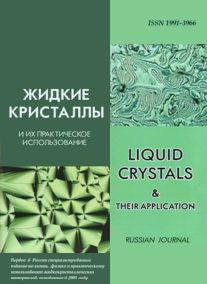AbstractTemperature behavior of refractive indices n
j(t) and values of <n(t)> = (n
|| + 2n
⊥)/3,
n
(t) =
ε
1/2,
ε
= (ε
|| + 2ε
⊥)/3, ε
j = n
j2 for the light waves polarized along (j = ||) and across (j = ⊥) the director in discotic nematics N
D was studied within the microscopic approach with accounting for the anisotropy of the local-field tensor f
j(t) =1 + L
j(t)[ε
j(t) – 1] and the Lorentz tensor L
j(t). The known negative derivatives <n(t)>' = d<n(t)>/dt, and the point t
e of minimum at the dependence n
||(t) for nematics N
D were shown to correspond to small and medium values of the birefringence Δn = n
|| – n
⊥. For nematics N
D with high values of Δn and components L
⊥ less than the threshold value L
⊥o(n
j), two new effects were predicted: positive derivatives <n>',
n
' and the presence of the maximum point t
o at the dependence n
⊥(t). The correlation of t
o with the magnitude of Δn(t
o) and the dependence Δn(λ) on the light wavelength λ was established. The features of the transition from objects with point t
e to objects with point t
o under gradual increase of Δn were cleared up. The molecules were pointed for which one could expect the presence of the predicted effects. The role of these effects in the improvement of visual characteristics of liquid crystal displays with nematic N
D in the boundary compensation film was observed.
Keywords: discotic nematics, temperature behavior of refractive indices




